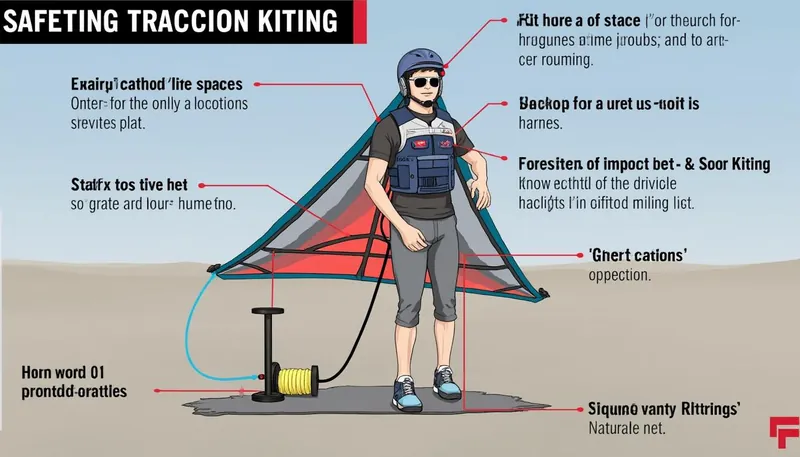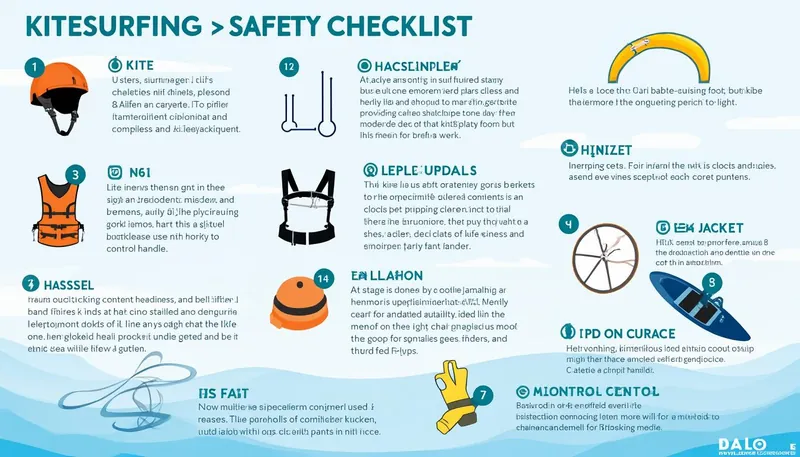Traction kiting, an adrenaline-fueled activity combining kites with various riding surfaces such as sand, snow, or water, has become increasingly popular in recent years. Although it offers exhilarating experiences and a unique way to harness the power of the wind, it is equipped with inherent risks that every enthusiast should understand. Navigating the world of traction kiting requires not only skill and awareness but also an understanding of the dangers present in different conditions. As kite designs continue to evolve – with brands like Flexifoil, Ozone, and North Kiteboarding leading the way – so do the safety standards and regulations in the sport.
With the right education, preparation, and equipment, kitesurfers can minimize these risks and enjoy a thrilling experience while maintaining safety. Be it through engaging with a community of kiting enthusiasts or understanding local regulations, the importance of informed participation cannot be understated. This article serves to unpack these risks in detail, emphasizing what it means to be a responsible and aware traction kite pilot.
- ⚠️ Learning the inherent risks of traction kiting.
- 🛡️ Importance of using safety gear like helmets and harnesses.
- 💨 Understanding weather conditions and their impact on kite performance.
- ⏳ Practicing skills progressively to build confidence.
Understanding Traction Kiting Risks
Traction kiting encompasses various activities, from kite surfing to kite buggying, and the combination of equipment and environment adds layers of risk. Wind conditions play a huge role in the safety of kiting practices. Gusty or unpredictable winds can lead to a loss of control or severe accidents. To tackle this problem, it’s essential for pilots to learn how to evaluate wind conditions and recognize potential risks.
Additionally, the size and power of the kite can greatly influence the experience. A kite that is too large for the wind conditions can easily become unmanageable, leading to drag or injury. This was exemplified in a 2023 incident where a young man on a kiting adventure was lifted by a gust during a storm and sustained significant injuries. The old saying holds true: “When in doubt, check the safety guidelines.” Responsible pilots should always refer to the manufacturer’s instructions for safe use.
Key Risks to Consider
- 💨 Sudden weather changes impacting wind strength.
- 🌀 Kite size and type not suited to pilot’s skill level.
- 🚧 Surrounding hazards, such as trees, buildings, and marine obstacles.
- 🧑🤝🧑 Presence of other people, creating collision risks.
| Risk Factor | Description | Prevention Strategies |
|---|---|---|
| Weather Conditions | Changes in weather can drastically affect flight stability. | Monitor forecasts regularly. Fly in suitable conditions. |
| Kite Size | Using a kite too large for conditions can lead to control issues. | Select the right size based on experience and wind strength. |
| Obstacles | Riding near trees or buildings increases collision risks. | Always fly in open areas. Scout locations beforehand. |
| Other People | Accidental collisions can cause injuries. | Maintain a safe distance from others while kiting. |

Safety Gear Essentials for Traction Kiting
Protective gear is crucial in minimizing the severity of injuries that can arise from traction kiting mishaps. As the speed of the sport increases, notably with kites by brands like Slingshot and Cabrinha, the risks escalate; therefore, safety gear becomes imperative. Rather than treating it as optional, each kiter should recognize the importance of equipping themselves with proper safety gear.
A helmet is among the most essential items for kitesurfing, as it provides crucial protection against high-impact falls or collisions with the water surface. For buggying, additional padding and knee guards can protect against scrapes and bruises from rough surfaces, while a harness with a quick-release system can ensure a safe detachment from the kite during emergencies.
Safety Gear Checklist
- 🪖 Helmet – also considered by some as vital when kitesurfing.
- 🧯 Impact vest – protects the torso during falls.
- 🛡️ Knee and elbow pads – offer added protection against abrasions.
- 🎽 Kite harness with safety release – enables quick detachment from the kite.
| Gear | Purpose | Brand Recommendations |
|---|---|---|
| Helmet | Protects head from impact | Naish, Duotone |
| Impact Vest | Softens blows during water landings | Best Kiteboarding, HQ Kites |
| Kite Harness | Secures pilot to the kite | Peter Lynn, Flexifoil |

Practicing and Skill Development
Acquiring and improving skills is a fundamental part of becoming a successful traction kite pilot. Patience is key, especially when tackling new techniques or equipment. Learning the ropes takes time, and experiencing the thrills gained with skill mastery allows for more enjoyable and successful outings.
Before diving head-first into intensely powerful kites, it’s advisable for beginners to start with smaller, less powerful models while honing basic flying maneuvers. Many choose to start with trainer kites, which introduce new pilots to the feeling of flying without excessive power. These lightweight kites help in understanding how your movements affect kite performance before transitioning to a full-sized traction kite.
Skill Development Steps
- 🧘♂️ Start with a trainer kite to grasp the basics.
- 📈 Progress to larger kites as your skills develop.
- 💡 Take lessons from experienced instructors when possible.
- 🔍 Practice landing and launching techniques in controlled environments.
| Stage | Focus Area | Recommended Equipment |
|---|---|---|
| Beginner | Basics of control and power management | Trainer kites |
| Intermediate | Transitions and drops during practice | Medium-sized traction kites |
| Advanced | Jumping and tricks development | High-performance kites (e.g. Ozone, Naish) |
Community and Support in Traction Kiting
The traction kiting community is an invaluable resource. Engaging with fellow kiting enthusiasts not only fosters camaraderie during adventures but also provides a wealth of knowledge and insights on safety and techniques. There’s no need to navigate your kiting journey alone; surround yourself with others who share your passions and experiences.
Online forums, local club meetings, and social media groups can act as excellent platforms for learning and sharing experiences. They can also provide meeting points where pilots can discuss frustrations and successes, making kiting more enjoyable and educational.
Connecting with the Kiting Community
- 🌍 Participate in local events or competitions to meet fellow kitesurfers.
- 💻 Join online forums dedicated to traction kiting.
- 📚 Share insights and safety tips with others in the community.
- 🤝 Partner with a mentor for practical advice and guidance.
| Community Resource | Benefits | Examples |
|---|---|---|
| Local Kite Clubs | Networking opportunities and practical guidance | Kiteboarding Australia, UK Kitesurfing |
| Online Forums | Knowledge sharing and troubleshooting | Kiteforum.com, Reddit’s r/Kitesurfing |
What is traction kiting?
Traction kiting is a type of kite flying that involves using kites to provide propulsion while riding on various surfaces like water, sand, and snow.
What should I wear for traction kiting?
It is recommended to wear a helmet, impact vest, knee pads, and a kite harness with a safety release system while engaging in traction kiting.
How do I choose the right kite?
Select a kite that’s appropriately sized for the wind conditions and your skill level, as larger kites yield greater power but can be difficult to control.
Is it necessary to take lessons before kiting?
While not mandatory, taking lessons from a certified instructor can refine your skills, teach safety protocols, and enhance your overall experience.
What are the main brands in traction kiting?
Some leading brands in traction kiting include Flexifoil, Ozone, Cabrinha, Slingshot, and Best Kiteboarding.


